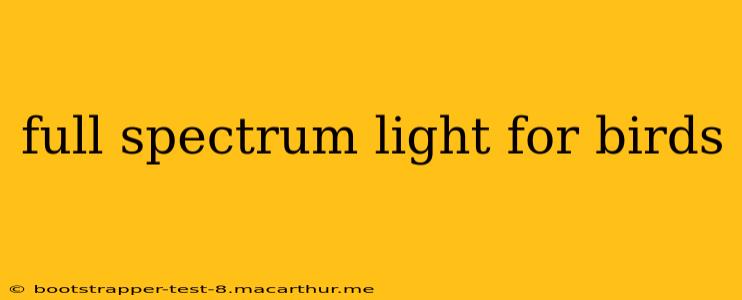Full spectrum lighting is increasingly popular among bird owners, promising a healthier and happier avian companion. But what exactly is full spectrum light, and does it truly benefit birds? This comprehensive guide delves into the science behind full spectrum lighting, its potential benefits and drawbacks, and how to choose the right lighting for your feathered friend.
What is Full Spectrum Lighting?
Full spectrum lighting aims to mimic natural sunlight, encompassing the entire range of visible light wavelengths, as well as some invisible ultraviolet (UV) and infrared (IR) light. Unlike standard incandescent or fluorescent bulbs, which often omit certain wavelengths, full spectrum bulbs strive for a more complete light spectrum. This broader spectrum is believed to be crucial for various biological processes in living beings, including birds.
Does Full Spectrum Light Benefit Birds?
The purported benefits of full spectrum lighting for birds are numerous:
-
Improved Health: Many bird owners believe full spectrum lighting supports a stronger immune system and reduces the likelihood of illness. The increased UV light can also help birds synthesize Vitamin D, vital for bone health and calcium absorption. However, scientific evidence directly linking full spectrum lighting to a significantly improved immune system in birds is still limited and requires further research.
-
Enhanced Breeding: Some studies suggest that full spectrum lighting can positively influence breeding cycles in certain bird species, stimulating egg laying and increasing reproductive success. The increased UV light mimics the natural increase in sunlight during the breeding season.
-
Vibrant Plumage: The broader spectrum of light might enhance the vibrancy of a bird's plumage, making the colors appear more intense and natural. This is largely due to how the different wavelengths of light interact with the bird's feathers.
-
Increased Activity and Engagement: The closer mimicry of natural daylight can lead to more natural activity patterns, improving a bird's overall well-being and mental stimulation. This is particularly beneficial for birds kept indoors, which may otherwise experience limited exposure to natural daylight.
What are the Potential Drawbacks of Full Spectrum Lighting for Birds?
While full spectrum lighting offers several potential advantages, it's essential to be aware of potential downsides:
-
UV Overexposure: Too much UV light can be harmful to birds, potentially leading to skin damage or eye problems. It's crucial to choose bulbs with appropriate UV output and ensure they are positioned correctly to avoid direct, intense exposure.
-
Heat Generation: Some full spectrum bulbs generate significant heat, which can be dangerous for birds, particularly in warmer climates or smaller cages. Always check the bulb's specifications and ensure proper ventilation.
-
Cost: Full spectrum bulbs often cost more than standard lighting options.
-
Not a Replacement for Natural Sunlight: While beneficial, full spectrum lighting should not be considered a complete replacement for natural sunlight. Birds still benefit from some exposure to natural light whenever possible.
What Type of Full Spectrum Light is Best for My Bird?
Choosing the right full spectrum bulb depends on the species of bird, the size of the cage, and the overall environment. Look for bulbs specifically designed for avian use, often labeled with details about their UV output (UVA and UVB). Always follow the manufacturer's instructions regarding distance and usage.
How Much Full Spectrum Light Does My Bird Need?
The recommended duration of full spectrum lighting varies depending on the bird species and its natural environment. Research your bird's specific needs to determine the appropriate lighting schedule. Typically, 10-12 hours a day is considered sufficient for many species, mimicking natural daylight hours.
Can I Use Regular Bulbs Instead of Full Spectrum Bulbs?
While regular bulbs provide light, they lack the beneficial UV and broader visible spectrum that full spectrum bulbs offer. While they can supplement lighting, they are not an adequate replacement for full spectrum lighting if you want to maximize the potential benefits for your bird's health and well-being.
Conclusion
Full spectrum lighting can be a valuable addition to your bird's environment, offering several potential benefits for their health and happiness. However, careful selection, proper placement, and understanding of potential drawbacks are crucial to ensure its safe and effective use. Always prioritize the overall well-being of your bird, considering full-spectrum lighting as one aspect of providing a nurturing and enriching environment. Remember to consult with an avian veterinarian for personalized advice tailored to your bird’s species and individual needs.
